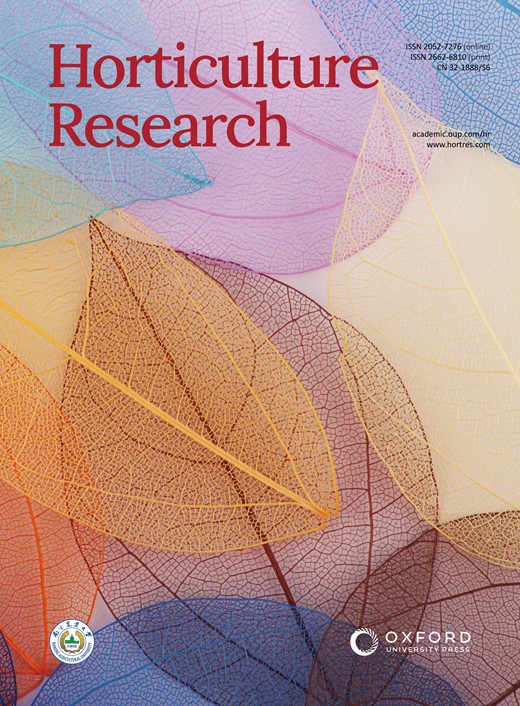PpERF17通过激活茉莉酸和γ-氨基丁酸的生物合成,缓解高CO2环境下桃果采后的冷害
IF 8.7
1区 农林科学
Q1 Agricultural and Biological Sciences
引用次数: 0
摘要
内部褐变(IB)是桃果实长期冷藏后常见的冷害(CI)特征。我们之前的研究表明,低氧和高二氧化碳(eCO2)条件下的改良气氛(MA)贮藏通过促进茉莉酸(JAs)和γ-氨基丁酸(GABA)在'Zhonghuashoutao'('ZHST')桃果实中的积累来减轻 CI。在这里,我们发现仅 10% CO2 就能提高耐寒性,乙烯响应因子 17 (PpERF17) 被确定为促进 JAs 和 GABA 生物合成的关键转录因子 (TF)。在烟草中稳定转化 PpERF17 可减少冷害,这归因于过氧化氢(H2O2)和丙二醛(MDA)水平的降低,以及 JAs 和 GABA 积累的增强。此外,在 eCO2 条件下,PpMYC2.1可激活13S-脂氧合酶(Pp13S-LOX)、烯氧化物合酶(PpAOS)、12-氧代植物二烯酸还原酶3(PpOPR3)和谷氨酸脱羧酶(PpGAD)的转录,同时还可诱导上游TF PpERF17的表达,从而建立起上调JA和GABA生物合成的正反馈回路。最后,在果实从冷库转移到货架前施用茉莉酸甲酯(MeJA)可减轻冷害的发展,这是因为相关生物合成基因的表达提高导致 JA 和 GABA 的积累增加。总之,我们的研究结果表明,eCO2-诱导的 PpERF17 在激活 JA 信号通路的同时,也增强了 JA 和 GABA 的积累。这促成了由 PpMYC2.1 介导的正反馈循环,最终通过 JA 和 GABA 的持续积累缓解了桃果的 CI。本文章由计算机程序翻译,如有差异,请以英文原文为准。
PpERF17 alleviates peach fruit postharvest chilling injury under elevated CO2 by activating jasmonic acid and γ-aminobutyric acid biosynthesis
Internal browning (IB) is a common chilling injury (CI) feature in peach fruit after prolonged cold storage. Our previous study demonstrated that low O2 and elevated CO2 (eCO2) condition of modified atmosphere (MA) storage alleviated CI by facilitating the accumulation of jasmonic acids (JAs) and γ-aminobutyric acid (GABA) in ‘Zhonghuashoutao’ (‘ZHST’) peach fruit. Here we show that 10 % CO2 alone can improve cold tolerance, with ethylene response factor 17 (PpERF17) identified as a pivotal transcription factor (TF) that promotes biosynthesis of JAs and GABA. Stable transformation of PpERF17 in tobacco resulted in reduced cold damage, attributed to decreased levels of hydrogen peroxide (H2O2) and malondialdehyde (MDA), as well as enhanced accumulation of JAs and GABA. Moreover, under eCO2, PpMYC2.1, the master regulator of JA signaling, was found to activate transcription of 13S-lipoxygenase (Pp13S-LOX), allene oxide synthase (PpAOS), 12-oxophytodienoate reductase 3 (PpOPR3) and glutamate decarboxylase (PpGAD), while also inducing the expression of the upstream TF PpERF17, thereby establishing positive feedback loops upregulating JA and GABA biosynthesis. Finally, application of methyl jasmonate (MeJA) to fruit before shelf transfer from cold storage alleviated chilling injury development, due to increased accumulation of JAs and GABA as a result of raised expression of related biosynthetic genes. Collectively, our results suggest that eCO2-induced PpERF17 enhances JAs and GABA accumulation while activating the JA signaling pathway. This contributes to a positive feedback loop mediated by PpMYC2.1, ultimately alleviating CI of peach fruit through the sustained accumulation of JAs and GABA.
求助全文
通过发布文献求助,成功后即可免费获取论文全文。
去求助
来源期刊

Horticulture Research
Biochemistry, Genetics and Molecular Biology-Biochemistry
CiteScore
11.20
自引率
6.90%
发文量
367
审稿时长
20 weeks
期刊介绍:
Horticulture Research, an open access journal affiliated with Nanjing Agricultural University, has achieved the prestigious ranking of number one in the Horticulture category of the Journal Citation Reports ™ from Clarivate, 2022. As a leading publication in the field, the journal is dedicated to disseminating original research articles, comprehensive reviews, insightful perspectives, thought-provoking comments, and valuable correspondence articles and letters to the editor. Its scope encompasses all vital aspects of horticultural plants and disciplines, such as biotechnology, breeding, cellular and molecular biology, evolution, genetics, inter-species interactions, physiology, and the origination and domestication of crops.
 求助内容:
求助内容: 应助结果提醒方式:
应助结果提醒方式:


